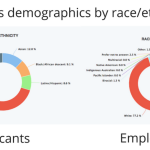This Tech Veteran’s Ultimate Guide To Leading Through Layoffs
The Grateful Dead, Jimi Hendrix, and U2 aren’t the only ones who can fill up the iconic Red Rocks Amphitheatre in Colorado. If every person that Beth Steinberg has helped hire took a seat at the venue, about 500 people would be left standing. They’d hail from fashion retailer Nordstrom to gaming giant Electronic Arts, from solar provider Sunrun to social network Facebook.
Any talent leader knows how astoundingly hard hiring can be—until they execute a layoff, which Steinberg has had to do at least once at nearly every company she’s worked. If you think hiring 10,000 people over a career sounds daunting, try laying off 2,000 of them.
Steinberg started her career with a decade in retail, in which layoffs are common given the seasonality of the sector. As she began working with more technology companies, she managed another type of expansion and contraction cycle, but this time mirroring the ebb and flow of capital and talent. In addition to some of the aforementioned names in technology, Steinberg has advised several organizations such as Ideo.org, Puppet Labs, and Hackbright Academy.
Permanent layoffs—or what are more accurately known as reductions in force (RIFs)—are terminations rooted in structural and market-based changes, versus the performance of specific individuals. Here, Steinberg addresses the four phases of a permanent layoff and outlines the people to convene and steps to take during each stage. Drawing from anonymized examples from her career, she brings tactics to one of the most difficult times a company faces and what to expect from a leader, terminated employees, and the team that remains.
Layoffs Are About People And Hinge On Process
When it comes to layoffs, Steinberg has worked with leaders who are incredibly empathetic with employees but lack experience, as well as those who can lead layoffs methodically, but without a keen awareness of their impact on their team. The key is to get those elements in equal proportion.
“Layoffs are first and foremost about your people: those who will be let go, those who remain with the company, and the leaders who guide the company through the process. So while it’s a business decision, what’s in motion are the people you’ve hired and have helped you build,” says Steinberg.
Every company wants leaders who naturally understand and guide their company according to this principle. But even the most capable leaders can falter when emotion, inexperience, and pressure come into play. That’s why you need a process that orients leaders and couples attentive management with a thoughtful plan.
Before You Know It’s Coming
Steinberg still remembers the experience that shaped her current philosophy toward layoffs because it caught the entire company off guard. “It was my first HR leadership position at a very early-stage startup. Over 18 months, we grew from about 50 to over 300 people. Headcount went unchecked as we went after a business model we thought worked,” she says.
Turns out we didn’t have the model to justify our team. We needed to get our burn rate down immediately. The layoff strategy was haphazard; some decisions were based on performance, team, popularity. Thinking back, it was entirely the wrong approach in every possible way.
The most disastrous part was the leadership at the top. “Our CEO had very little—if any—accountability and actually did not come to work the day of the layoffs. So the CFO, a few other managers, and I had to sit down and lay off about half the company,” says Steinberg. “It was very painful experience because there was not a lot I could say that made me feel like we were doing the right thing. Years later, it still makes me sad and wonder what else I could have done.”
When Steinberg works with leadership teams, she makes a note to double-check that headcount is justified whenever hiring plans are being discussed. “It’s not to be a killjoy, but to add in a checkpoint. It’s hard work to get funding or close a big customer, so when there’s the opportunity to grow, the first reaction is often to hire more people. It’s as if it sends a signal that the company is making it,” says Steinberg.
I realize now that I had the strength to step in and lay off people. I just wish I’d had a stronger voice earlier on and asked, ‘Why are we hiring all these people?’ The truth is that there needs to be an awareness before there’s a strategy. If your hiring plan is one side of the coin, your layoff plan is the other side.
Steinberg understands that the quick turns of company building make this type of methodical thoughtfulness around layoffs at the onset not easy—especially for startups. So she suggests taking incremental steps to usher in that philosophy:
Map out capabilities, not just headcount. “When managers grow teams, I often see them conflate people with skill sets. They need a sales director, so they immediately think of that profile existing in a separate person, often outside their company. If that happens with every team leader, all of a sudden the company is hiring left and right,” says Steinberg. “By the time you define a profile, put lines out into the market, vet candidates, interview, hire, exten d an offer, set a start date, onboard and get the hire spun up, you could be looking three to six months down the line. And that’s probably conservative.”
Instead, define the skill sets you want. Says Steinberg:
By extracting the skill sets you need from the person you think might have them, all of a sudden there are many other ways of obtaining the capabilities you need to grow. You may still need to hire, but maybe you’ll realize that a freelancer or contractor can supply what you need. Or an employee you already have is able to grow into that skill set in the same amount of time it’d take to hire someone else—and would be current with institutional knowledge.
From a management point of view, these types of options keep your workforce flexible and lean. Also, employee development not only gives you more depth with your existing workforce, but it’s a retention mechanism. They’re not mutually exclusive, but instead of just immediately growing headcount, you’re also developing talent.
Steinberg has helped not only heads of people develop these talent plans, but also entire leadership teams. “All group leaders should go through the exercises of mapping out the skill sets they need 12–18 months down the line. I know it’s hard because they’re stretched already to hit pressing goals, but it makes life much easier over the long run,” she says.
“I’m working now with a leadership team that’s never done talent planning. I told them that if their talent lead knew what they might need 12–18 months from now from a skill perspective, they can start seeding those relationships now. Some upfront work would make their lives—and the talent leader’s life—much easier.”
For leaders or startups that need to keep talent planning low-lift, Steinberg can boil down a conversation about critical positions into five key questions:
- What is the position that’s needed?
- What are the key skills and competencies?
- When will these skills be needed?
- Why will they be needed/what is the work?
- Who are potential internal candidates or external profiles who could fulfill this work?
This lightweight version is powerful when it rolls up to give a talent leader or founder a sense of the skill sets the entire company will need down the line. “The mind-shift from headcount to skill sets is one shift; a systematic way to track those needs is another,” says Steinberg.
A budget is not just a number, but a signal. One of the immediate challenges facing leadership teams at growing companies—especially quickly scaling, dynamic startups—is deciding how and what information should flow throughout the company. Says Steinberg:
It’s hard to know where to start, so here’s what I recommend: All people leaders, from the C-suite to the frontline leaders, get exposure and access to view the annual budget. I’ve seen how this act has made founders nervous or fearful, but also how they relax when their people rise to the responsibility of what’s been shared with them.
Here’s what happens: The health of the company is no longer an abstract concept. They see in print how the biggest expenses are facilities and salaries and how increasing those fixed costs quickly make burn rate accelerate over time. It’s the only way managers will learn and get better.
When this exposure happens long before any sign of a layoff, it is an act of trust and every part of the leadership is empowered. When it’s done just before or after the layoff, it’s an explanation more than an education. There’s a power vacuum, and exposure at that stage of the game makes middle and frontline managers feel informed by—not in line with—their leadership.
“Create a view-only, shared document that, at minimum, outlines budget and projected headcount for each team. I encourage leaders to share the entire budget to avoid different versions throughout the organization,” says Steinberg.
Then bring in the finance leader if there is one—or an external consultant, if not—to explain the budget and budgeting process for non-finance leaders. It sounds basic, but this act is as critical to the long-term health of a company as the budget itself. Thereafter, set a quarterly check-in to provide voiceovers to any changes. Then, when there’s talk of needing to reel back to get to profitability or to raise more money, you’ll be surprised how people rally around a goal driven by information they’ve been entrusted with.
Otherwise, there’s a lot of ground to cover when something like a layoff hits. “Without that exposure to the business plan and budget, a freeze in headcount and impending layoff will catch the company off-guard,” Steinberg says.
For leaders who hesitate with transparency or worry that their decisions will be called into judgment, I remind them: People can usually handle the truth, but they can’t handle feeling as if they’ve been deceived or purposely left in the dark. That feeling seeps into the culture and dissolves the conditions that allow people to do their best work.
When You Know It’s Coming
A layoff shouldn’t be a surprise to leaders, nor to its people. It’s not something that happens to a company. It’s an act by its leadership when no other routes can be pursued. In other words, when a layoff is your way forward, you should implicitly be telling people that you’ve exhausted every other route. Here is what you should have already considered:
Delay hiring:
It’s not uncommon for companies to move resources from one quarter to a later quarter. Leaders should ask their people managers to look at their goals and headcount asks, and then see what’s realistic to move. I’ve never had leaders not work together to delay and reprioritize hires.
Cut salaries:
I’ve been at a company where every senior leader didn’t take a bonus—which amounted to about 33% of our pay—in order not to have to lay anybody off. For many, the cut felt substantial. Not every senior team will like it, but driving accountability at the highest levels is paramount and can prevent a layoff.
Reset the senior/junior employee ratio:
If a layoff is about helping return a company to financial health, senior members should not be immune to a layoff, as they can account for a big chunk of expenses. It depends on the company, but a good rule of thumb is that senior leaders should make up less than 5% of the headcount. I’ve seen companies as high as 20%. Factoring in equity, there’s a huge delta between the compensation of senior and junior staff.
Scale back perks as well as travel and expenses:
This isn’t the first lever to pull to scale back costs, but it could be a significant budget line, especially in smaller companies. At one organization, they had 15 different types of chips. The very tools used to delight and retain employees might put the company at risk down the line.
Consult with your board:
Changes in customer buying behavior is the first signal many companies should get that market forces may be shifting. However, leaders familiar with—but who are external to—your company are especially helpful if they’ve operated or invested in similar organizations or funding cycles. Keep those channels open. Not only do they have a vantage point to help spot potential downturns or droughts of capital, but they’ll have ideas on what has worked to weather these changes.
When alternatives are being explored, there is a core group that’s involved in evaluating options. “In a startup, it may include the cofounders and the board. With larger companies, that may involve the CEO’s executive team. In both cases, it’s standard that in-house or external counsel is involved to ensure legal compliance and act as a sounding board,” says Steinberg.
Each executive has a part to play—such as running numbers or preparing legal documents—in evaluating the alternatives to a layoff. There’s a lot of detailed work and careful review that goes into this process. Don’t cut corners. You need to always remember that you’re talking about people and in the process of taking away their jobs.
How to convene this core group that’s evaluating alternatives is also key. “I recommend that those weighing the options convene as conspicuously as possible—perhaps either very early or late during a work day. This is not for focus or to be excessively secretive, but to avoid worrying teams unnecessarily,” says Steinberg.
If people see their leaders—who may not meet all together in this way regularly—locked in a meeting room, they’ll think something bad is going on. Speculation not only starts the rumor mill, but halts productivity. Until it’s been decided that layoffs are the only way forward, there’s no reason to let people feel anxiety.
Inform and equip your senior leadership. Where many leaders understandably struggle is how, when, and with whom to share the news that a layoff is coming once people outside the most senior decision makers must know. News travels quickly, so laying the groundwork to manage internal communications is the first step to initiating a layoff. Here are a few tips from Steinberg on sharing the news internally:
Justify your confidentiality:
After the core team who evaluated the alternatives, the next group of people who should receive the news are the leaders of each team. If they were involved in the initial collective, then it’s all people managers.
If possible, meet in-person with the most senior tier of management who wasn’t involved in the initial evaluation. Share the problem you are trying to solve and run through the alternatives that you evaluated. Let them ask questions. Your thorough diligence and an open forum is a key way to gain their empathy and confidence.
Ask for your people managers’ help:
The link between the senior management and next level of people managers is critical. As mentioned earlier, they should have context already around the budget and hiring plans, but they’ll still need to digest the news and ask questions. Once they have, you must ask for their partnership to help roll out the news.
I’ve seen situations where managers and their people were told in the same conversation that their people were being laid off. That’s demeaning to the manager. There’s always a challenge when cascading news during layoffs, but it’s more vital to trust that your managers will have discretion than to have them feel undermined.
Anchor to the definition of a layoff:
There will be a range of emotions. This is where getting wording right matters, especially to your senior leaders, who will field questions after the layoff is announced. A talent head or coach must train leaders and practice these conversations with them.
They must help them be crystal clear that a layoff is very different than terminating people for bad performance. This is not about something the employee has done wrong. Many people lump them together, but a layoff is defined as the elimination of job or function, not a specific person.
When It’s Happening
Steinberg has seen a range of viable layoff communications plans—and outlines a few of them below—but feels most strongly about how quickly a layoff should happen. “From announcement to exit conversations, the information should flow through your organization through established channels in hours if it’s a small startup, or days, if it is a large company,” says Steinberg. “If it draws out for multiple days or weeks, it generates anxiety for all: managers, their reports, and the leadership. Not only is it cruel, but it brings productivity to a trickle.”
That’s why laying the groundwork for a layoff is not only so important for leadership and culture, but for the speedy dissemination of information. Says Steinberg:
Managers who have access to a current budget and updates to headcount projections are not caught off guard when layoffs might happen. That transparency leads to increased trust in leadership, which brings credibility to the executive team when it says a layoff is necessary after considering all the options.
Only if that prework has been done will a leader be able to go from making a decision regarding a layoff to disseminating it through her senior management efficiently. If not, all efforts will be toward building relationships versus disseminating information—not ideal when there’s urgent news to share.
There are two approaches to breaking the news internally. When the a layoff is about to be announced to the entire company, Steinberg has seen two main approaches work:
- The company calls an All-Hands. The CEO makes the announcement. People return to their desks and direct managers start having team and one-on-one conversations.
- Direct managers announce the news to their teams. The company calls an All-Hands. The CEO expounds on the news. People return to their desks to have one-on-one conversations.
Says Steinberg:
Which way to announce the layoff depends on the culture of the company. I’ve always pressed leaders to consider which option they think is better suited for their people, even if it’s not easier for them. By and large, the more transparent the culture, the more frequently they start with the All-Hands.
In cases where there’s not a periodic All-Hands or frequent interaction with the CEO, I’ve seen the second option work better. Either way, the people should convene to receive a message from their CEO and have the chance to ask questions in a small group. Regardless of order, they should both happen in immediate succession so information is contained as much as possible until everyone has spoken with their direct manager.
Regardless of order, when the CEO speaks, she should hit a few main points. “First, the CEO takes accountability. It’s the leader’s job to bring together the right advisers, intelligence on the market, and senior leadership to avoid needing to use this tool of last resort,” says Steinberg. “Pretending that it’s someone or something else’s fault causes a lot damage. The CEO and leadership team are accountable for the health of the company. You admit what went wrong, commit to fixing it, outline your plan, and restate that you’re taking accountability for it.”
If a message about layoffs can ever crescendo, it should do so around the summary of the plan forward. Says Steinberg:
There needs to be conviction in the way ahead, not only to show that the layoff was not for nothing, but to reassure those who’ve believed in—and have worked hard for—the company. It’s not easy, but, as much as possible, a leader needs to think of this as a structural change that will also allow people to keep their jobs and drive toward a vision.
The final point should be an assurance that all measures have been taken to ensure this happens once and without more rounds of layoffs in the near future. “You don’t want your people to have a lingering fear that more people are going to be laid off. I was at a company that laid off five to six people every week for four months because the leadership thought it’d be better for optics,” says Steinberg. “But it became a morbid joke where people would guess whose turn it was each week. As you’d expect, people lost their trust in the company and productivity and morale plummeted.”
When To Break The News Externally
When it comes to leaks about a layoff, Steinberg admits that that’s a curveball that can come at leaders. “There are ways to minimize the risk of leaked news of your company’s layoff, but the moment the consideration is shared with anyone outside the CEO, it could happen. A layoff is as much a litmus test of leadership and culture as it is a milestone for a company,” says Steinberg. “You may wonder if you can trust your senior leaders and direct managers with an important, confidential message. Now you’ll find out. And that realization of the company you’re running is more precious than a potential leak.”
That said, there are measures that can help control the message outside of your company’s walls. “Of course, you want to get ahead of any leak or review on Glassdoor. I’ve seen the most success when the Marketing or PR lead has a press release queued up and media contacts ready to receive it,” says Steinberg. “The lead clicks send the moment the CEO announces the news at the All-Hands to the company. Many CEOs also work with teams to prep a more personal blog post. All these techniques are signals that a company isn’t hiding from the news and it wants to address what’s happening in its own words.”
Considerations For Terminated Employees
In order to execute a layoff expediently, direct managers should be the ones to deliver the message to each terminated individual. In addition to training with a HR or People team leader, Steinberg says that in-house or external counsel can be a resource for what absolutely shouldn’t be said. Here are her tips on a few key issues:
Severance:
There’s a big range. I’ve seen a company that laid off people after eight years and gave them two weeks. Another company overhired and, in wanting to own their error, gave a generous two months to everyone.
It’s all dependent on the plan to getting back to financial health. Most people grant varying amounts of severance by tenure and seniority. It’s different for public companies, but I’m not a fan of doing a severance policy up front, as situations are different and require flexibility.
Walking out:
Layoffs typically range from being effective immediately to two weeks out. Either way, have boxes preordered so that people have a way to carry out their belongings if they wish as soon as they hear the news.
I always recommend that direct managers give laid-off employees options. They can pack up and go home immediately after the announcement. Or they should offer to meet them over the weekend, if they prefer to pack up with fewer people around. Respect them by trusting that they know what they need. Be present and helpful.
Help finding new jobs:
At past companies, the talent team and I have worked with anyone who wanted help, by reviewing their resume or supplying intros to other companies. We assigned each recruiter a functional areas to support those in non-technical and engineering roles who were let go. Also, the CEO worked with the board and investors whose other portfolio companies had open jobs.
This puts action behind the reality that a layoff was a business decision, not about the people as people. Don’t just let go and cut ties. Take it personally so those laid off don’t.
Just as preparation for a layoff begins long before it might happen, so are there important steps to take after those laid off leave. “I recommend the same all-hands and small group session combination for employees who are still with the company. The CEO should readdress what this change means for the company and explain the organizational structure and plan going forward,” says Steinberg. “The small group sessions focus on asking employees three questions that are more difficult to cover in one large session. They are: Is it clear why this happened? Do you have any questions about our new plan? Is there anything we could’ve done better?”
“Give people time to grieve because they lost friends and colleagues. But, after that, quickly orient the company to the future. There should be a celebration of the contributions of those who have left and those who remain. Don’t pretend it never happened, but focus on what’s next,” says Steinberg. “After a layoff, I’ve seen companies host happy hours or lunches. These are routine acts that can help reinstate some sense of normalcy. When a layoff has gone as well as it can go, you’ll eventually see former employees return to visit. The best companies host alumni events and online forums to encourage these relationships.”
Ultimately, you want former employees to eventually acknowledge that it was a bad and difficult situation, but not at fault how it was handled. “I’ve personally tried to write handwritten notes to everyone who’s been impacted by a layoff. I let them know that if they need anything to please let me know,” says Steinberg. “Many people write back notes of appreciation or return to visit and thank me in person. It’s about making an effort as a human being. It may take longer to write a note—it doesn’t scale—but those gestures endure and define your company.”
Bringing It All Together
A layoff is difficult to discuss and even harder to execute. It’s a tool of last resort that can revive the financial health of a company when nothing else will. To avoid using it, give your people leaders—down to the newly minted frontline manager—access to current, projected headcounts and budgets. This information should be coupled with financial education and quarterly updates.
By establishing this common knowledge and relationship, leaders will be able to more easily mobilize and count on their managers to help roll out a layoff efficiently if it’s necessary. Layoffs should be done quickly, but with consideration of those leaving. Leaders must be able to articulate which alternatives were considered. Those staying will take note of how their colleagues are handled. The leadership and talent team should use their networks to help place former colleagues, while the CEO must guide the company to its next chapter.
“The memory of Silicon Valley—and other entrepreneurial hubs—is long. That’s why it’s so important to do what you can upfront to lay the groundwork should a layoff happen,” says Steinberg.
Fortunately, these preparations are also in-step with smart company building, such as getting teams to be as productive as possible, monitoring and sharing the levers of financial health with managers, and building trust through transparency with your teams. But even if all these gears are turning, bad luck happens. When the situation intensifies, don’t let yourself forget that those line items are people with lives and families interwoven with your company. You must act with empathy. That’s the only way to get through a layoff.
This article originally appeared on First Round Review and is reprinted with permission.
Fast Company , Read Full Story
(40)














